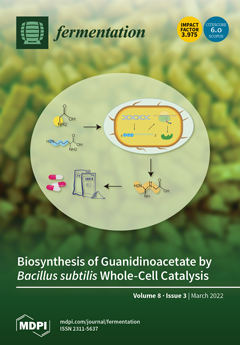Condensed tannins (CT) have been observed to reduce enteric CH
4 production when added to ruminant diets. However, high concentrations of CT in forages such as sericea lespedeza (SL;
Lespedeza cuneata (Dum. Cours.) G. Don) may depress nutrient digestibility. Oilseed crops, high in
[...] Read more.
Condensed tannins (CT) have been observed to reduce enteric CH
4 production when added to ruminant diets. However, high concentrations of CT in forages such as sericea lespedeza (SL;
Lespedeza cuneata (Dum. Cours.) G. Don) may depress nutrient digestibility. Oilseed crops, high in lipid concentration, also reduce enteric CH
4 via toxicity to methanogenic bacteria with less depression of nutrient digestibility. However, it is unclear whether combining these two feeds would result in even greater decreases in CH
4 without impairing ruminal fermentation. This study used an in vitro continuous culture fermentor system to determine if supplementation of ground oilseeds would further reduce enteric CH
4 production while improving nutrient digestibility of high-CT forages. The experimental design was a 4 × 4 Latin square, with four diets containing (dry matter basis) 45% orchardgrass (OCH;
Dactylis glomerata L.), 45% sericea lespedeza (SL;
Lespedeza cuneata (Dum. Cours.) G. Don), and 10% oilseed supplements, using canola (CAN;
Brassica napus L.), soybean (SOY;
Glycine max L.), sunflower (SUN;
Helianthus annuus L.), or a mix of all three species (MIX; in equal proportions). Fermentors were fed 82 g of dry matter/d in four equal feedings over four 10 d periods. Methane was recorded every 10 min, and effluent samples were analyzed for pH, volatile fatty acids, dry matter, organic matter, crude protein, neutral detergent fiber, and acid detergent fiber to determine apparent and true nutrient digestibilities. The CAN, SUN, and MIX diets had greater concentrations of crude fat (7–8 g/kg) than the SOY diet (5.7 g/kg), which contributed to the greater reduction in enteric CH
4 production in those diets (13–27 mg/d) compared to the SOY diet (84 mg/d). Apparent and true nutrient digestibilities were not affected by the addition of ground oilseeds. While N intake increased concomitant with crude protein increases in the diets, there were no additional effects on N flows. While supplementing a high-CT diet with any of the three oilseeds (canola, soybean, sunflower, or a mixture of the three oilseeds) reduced total CH
4 emission without depressing nutrient digestibility, canola and mixes containing canola were most effective. Further research is needed in vivo to evaluate whether these results translate to greater feed efficiency and animal production.
Full article





